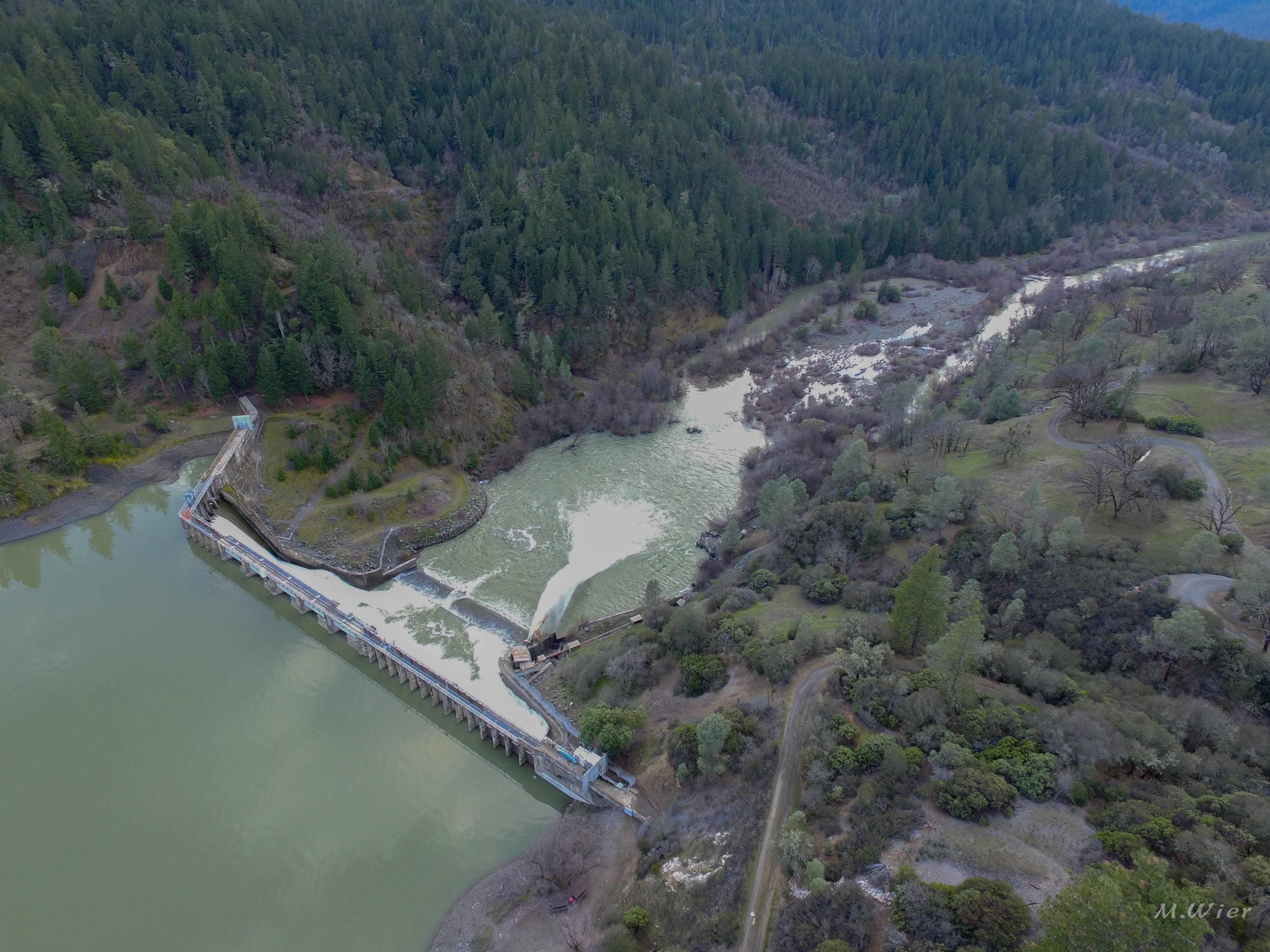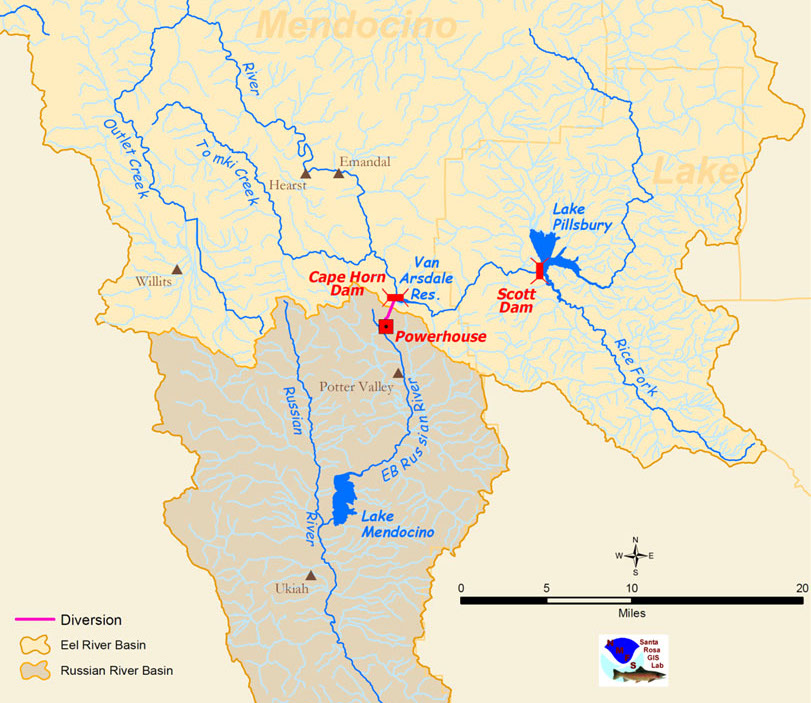Resolution
Sierra Club Redwood Chapter supports the restoration of fish passage to the upper main stem of the Eel River by removing Scott Dam and improving conditions at Cape Horn Dam, while maintaining water deliveries to Mendocino and Sonoma County agricultural users, and therefore supports the “Two Basin Partnership” relicensing proposal.
Background Information
For many years Pacific Gas & Electric (PG&E) has operated the “Potter Valley Project,” a hydroelectric facility on the main stem of the Eel River consisting of Scott and Cape Horn dams, a small electric generation plant, and a system of pipes diverting water into the Russian River watershed, where it is used for irrigation by farmers in Potter Valley and farther south in Sonoma County. The construction of Scott Dam in 1922 completely blocked passage of anadromous fish, including salmon and steelhead, while simultaneously forming Lake Pillsbury, a 2,000-acre reservoir in remote northwestern Lake County used for boating, fishing and camping. Consisting of several hundred dwellings, primarily on Mendocino National Forest leaseholds, but also including a scattering in private fee-simple ownership, this community has almost no permanent residents.
generation plant, and a system of pipes diverting water into the Russian River watershed, where it is used for irrigation by farmers in Potter Valley and farther south in Sonoma County. The construction of Scott Dam in 1922 completely blocked passage of anadromous fish, including salmon and steelhead, while simultaneously forming Lake Pillsbury, a 2,000-acre reservoir in remote northwestern Lake County used for boating, fishing and camping. Consisting of several hundred dwellings, primarily on Mendocino National Forest leaseholds, but also including a scattering in private fee-simple ownership, this community has almost no permanent residents.
As with all other substantial hydroelectric generating systems, the Potter Valley Project requires periodic relicensing from the Federal Energy Regulatory Commission (FERC). PG&E initiated the relicensing process in 2017, but withdrew its application early in 2019, stating that this operation has been a consistent money-loser for years and its fiscal prospects could only get worse given declining energy markets. Recent court decisions requiring that relicensing include provisions for fish passage costing many millions of dollars, made the financial picture even less tenable. PG&E’s current license will expire on April 14, 2022, potentially presenting significant risks and liabilities to local communities and the environment if the infrastructure is not maintained.
In response, Rep. Jared Huffman called together a diverse group of environmental organizations, water agencies, local governments and tribes, which formed an ad hoc committee to explore various options including the possibility of assuming the FERC license and continuing operations of both the hydro plant and the immensely more valuable export of water for irrigation.
The ad hoc committee then formed a working group composed members of California Trout, Humboldt County, the Mendocino County Inland Water and Power Commission, the Sonoma County Water Agency and the Round Valley Indian Tribe, which developed a plan it called the Two-Basin Partnership. This proposal would re-open the main stem of the Eel River to spawning runs of endangered salmon and steelhead, while maintaining electric generation and water deliveries to Mendocino and Sonoma counties. Lake Pillsbury would disappear.
In 2019 the Two-Basin Partnership initiated the process to become a regional entity qualified to apply for relicensing to own and operate the project. In spring 2020, it filed a feasibility study report and proposed project plan with FERC, which includes removal of Scott Dam, modifications to Cape Horn Dam to improve fish passage, and construction of new infrastructure to maintain reliable water supply to the Potter Valley area and exports to the Russian River. Water exports would take place during winter flows rather than in the summer, as they do presently, and would require increased storage at Lake Mendocino.
Many questions remain, which will be addressed in detailed studies required to support a final relicensing application. Besides addressing complex environmental issues, these studies would include an economic analysis designed to narrow down cost estimates, which vary wildly from close to $100 million to more than $500 million. 
Arguments For:
- Imperiled populations of salmon, steelhead and lamprey would plainly benefit from the removal of Scott Dam. According to ichthyologist Peter Moyle, more than 99 percent of available spawning habitat upstream of Soda Creek in the upper mainstem Eel River is blocked by Scott Dam, including Gravelly Valley, “some of the best historical spawning habitat in the drainage.”
- If the relicensing proposal is not accepted, FERC will have to initiate a “decommissioning” process that could, and very probably would, result in the removal of both Scott and Cape Horn dams; this result would also benefit the fish, but with less certainty and (a very important point) much more slowly. The populations are sufficiently at risk, and speed is of the essence.
- Decommissioning would also almost certainly result in the cessation of water exports to the Russian River watershed and possibly to Potter Valley as well. Affected users would have no choice but to seek alternative sources of supply, most likely groundwater, with effects on the aquifer that cannot be precisely predicted but are almost certain to be detrimental. Significant policy and regulatory sideboards would have to be put in place in the affected counties (Sonoma, Mendocino) to ensure there would not be “spin off” environmental impacts. It’s highly questionable whether the political will would be in place for these measures to be enacted.
- The longer it takes for dam removal, the worse the risk of catastrophic failure becomes, with threats to downstream communities and habitat.
Arguments Against:
- It is argued that the likely result of decommissioning—removal of both dams and restoration of historic flows to the Eel—would bring a more positive result for the fish than removal of Scott Dam alone. Although this assertion is quite possibly correct, it must be balanced against the greater delays and uncertainties accompanying decommissioning.
- Lake Pillsbury cabin owners argue that removal of Scott Dam would not correct all the impairments in the Eel, and they advocate for retention of the reservoir and development of alternative ways to provide fish passage. Since the deadline for submitting alternative relicensing proposals expired long ago, and since the cabin owners do not have the resources to take over operation of the facility, even if they wanted to, it’s hard to see how this viewpoint could prevail. Although they seem to be heavily influenced by wishful thinking, it’s also apparent that advocacy against the Two-Basin proposal serves as a delaying tactic.